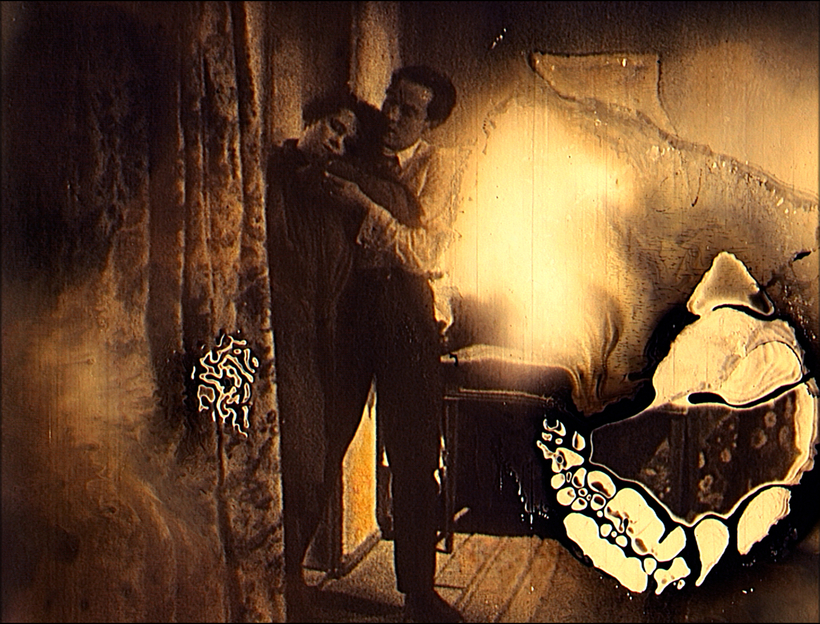A man and a woman stagger into an artist’s studio-duplex, he in his shirtsleeves, she in a trench coat, hanging her heavy head. Gently, he half-carries her upstairs to a mansard that could be nowhere but in Montmartre, and slips off the coat. Next thing you know, she’s lying in a brass bed, having sailed off to the Land of Nod. He stands beside her in an artist’s smock, smoothing the coverlet. Lovers? Strangers? What’s wrong? Who can tell?
These bewildering clips from the music video let me come in are what’s left of an obscure German silent of 1928 called Liebeshölle—literally Love’s Inferno but cited in English sources as Pawns of Passion. Apart from such bits and pieces, the film is lost or no longer in existence at all. It told of a Russian ballerina separated from her little boy at the time of the Russian Revolution, her attempted suicide in Paris, and her rescue by a heroic artist who pulls her from the Seine.
The flow of images as we see them now is the work of Bill Morrison, a specialist in repurposing archival film footage as deliquescent dreamscapes. The hypnotic soundtrack is David Lang’s song “let me come in,” voiced with seraphic purity by the soprano Angel Blue. Bryan Wagorn conducts. An instrumental trio—David Cresswell (viola), Anja Wood (cello), and Miles Salerni (percussion)—conjures up an acoustic space that is spare and lonely, open yet imbued with longing.
You may not suspect it, but we’re in Biblical territory here. The relevant verse—just one!—is Song of Songs 5:2, which in King James reads, “I sleep, but my heart waketh: it is the voice of my beloved that knocketh, saying, open to me, my sister, my love, my dove, my undefiled: for my head is filled with dew, and my locks with the drops of the night.”
Drawn to the thought like a moth to the flame, Lang assembled a poetic collage of his own, exploring translations far beyond King James. “I took 17 different versions of this verse,” he writes, “each slightly different, and then I alphabetized their phrases and got rid of all the duplicated lines, in order to make one single text, with all its interpretive angles shown.” Just as post-minimalist composers create moiré patterns in sound by layering each new snippet of music over a texture of slightly different snippets, Lang has created moiré patterns in words. The correspondences are sometimes plain to see, sometimes not. Who hears in the title let me come in an echo of King James’s archaic yet erotic “open to me”?
What correspondences there may be between Morrison’s salvaged movie footage and Lang’s construct of words and music are in the eye and ear of the beholder. Yet there’s no denying the incantatory synergy of their joint creation. Caveat: the sight of decaying film stock is quite the assault on a sensitive retina. Mesmerizing as the footage is, it feels really good when it stops.
let me come in is one in a series of digital shorts streaming on the Web site of the L.A. Opera. For full-screen viewing, it is best accessed on YouTube
Matthew Gurewitsch writes about opera and classical music for AIR MAIL. He lives in Hawaii

